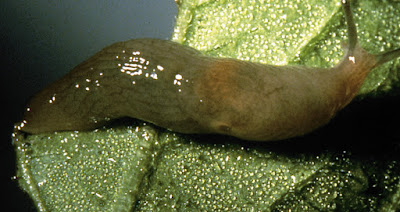 |
| Photo CSU Extension |
The wet spring and continuing storms have provided a banner crop of sugs in gardens along the Front Range of Colorado. I see their slime trails each morning glistening in the sunshine and see evidence of their voracious eating habits on my hostas in particular.
Slugs are very destructive and difficult to control. Seedlings of many vegetables and flowers are favored foods, and they feed on many fruits and vegetables prior to harvest. Even the slime trails produced by slugs can contaminate garden produce.
Dr. Whitney Cranshaw, Professor and Extension Specialist of Entomology at Colorado State University recommends the following:
9
 |
| Photo gardenmyths.com |
Techniques for Slug Control:
Reduce moisture in the garden. Slug populations depend on moisture in the garden to thrive. Any effort to reduce the amount of moisture will help with the problem. Use of drip irrigation and soaker lines and overhead watering early in the day will help reduce the humidity they thrive on.
Remove hiding places for slugs. Removing surface debris,avoiding organic mulches (straw, grass clippings) increasing air movement around plants and using trellises and wider plant spacing will help in reducing slug populations.
Use traps or trap boards to kill or concentrate slugs. Slugs are attracted to chemicals produced by many fermenting materials. Thus pans of beer or sugar-water can attract, trap and drown slugs. Place them throughout the plant to reduce slug populations. Alcohol is not the attractant to slugs; its the yeast fermenting in the beer. Boards and wet newspaper placed on the soil surface will have slugs that seek shelter under them. Check these shelters every morning and kill any slugs found.
Plant trap crops to divert slugs from main crops. Slugs love some plants more than others so planting them will divert slugs from your prized plants. Good trap crops include: green lettuce, cabbage, calendula, marigolds, comfrey leaves, zinnias and beans.
Use repellents or barriers. Slugs don’t like to travel over abrasive materials. Diatomaceous earth, wood ashes and similar materials placed around plants provide some protection. These materials must be kept dry however.
Apply baits according to label directions. Molluscicides are pesticides effective against slugs and snails, and are offered for sale in most garden centers. Read labels carefully and apply as directed. Many of these are harmful to pets and other wildlife and cannot be used on vegetables. Metaldehyde is the most commonly used and effective molluscicide. It is sold often in the form of granular baits (Bug-Geta, etc.) or as a paste or gel (Deadline, etc.) It is not to be used in the vegetable garden and is harmful to dogs in particular. An alternative bait that recently has become available includes iron phosphate (ferric phosphate) as the active ingredient. Trade names include Sluggo, Slug Magic and Escar-Go!, among others. Iron phosphate products can be used around edible crops and do not pose special hazards to dogs. Ammonia sprays make excellent contact molluscicides, but must be applied directly to exposed slugs. Household ammonia, diluted to a 5 percent to 10 percent concentration, is effective for this purpose.
For more information about slug control read this fact sheet: http://www.ext.colostate.edu/pubs/insect/05515.html



